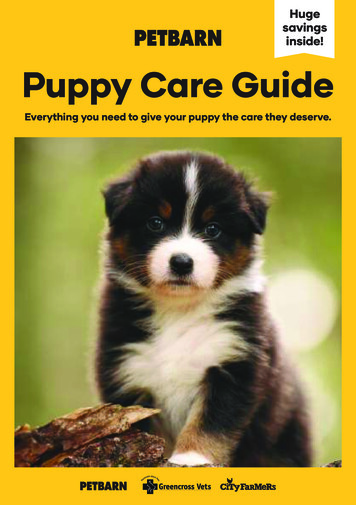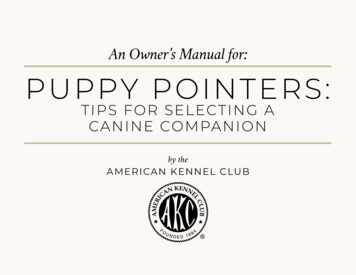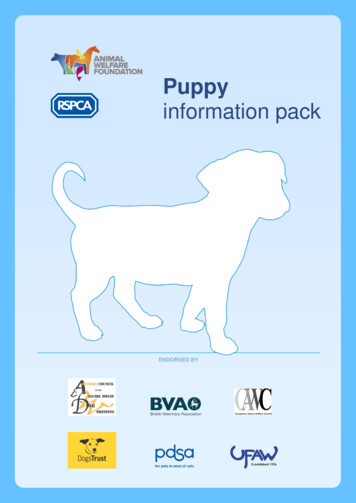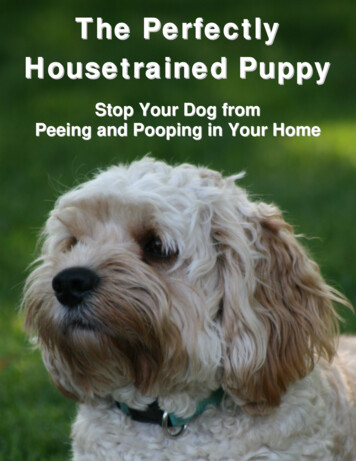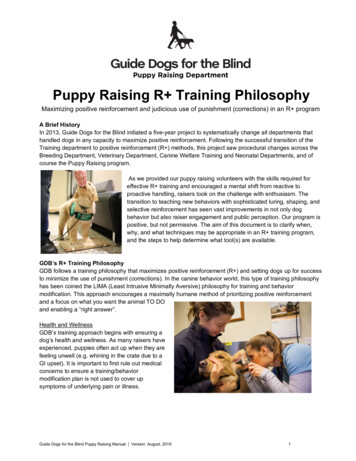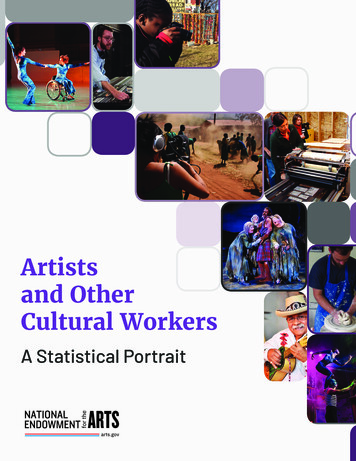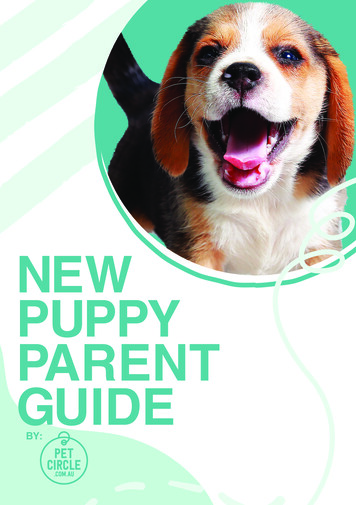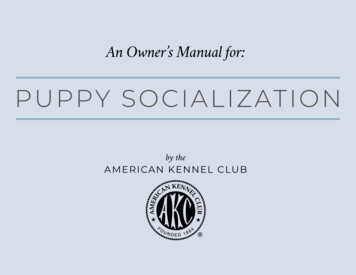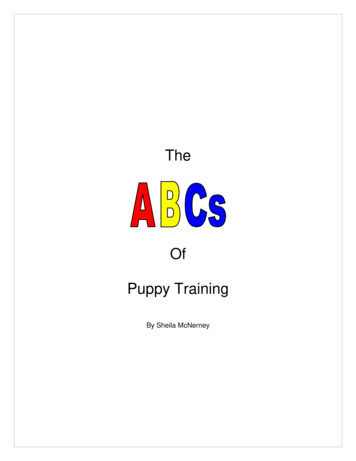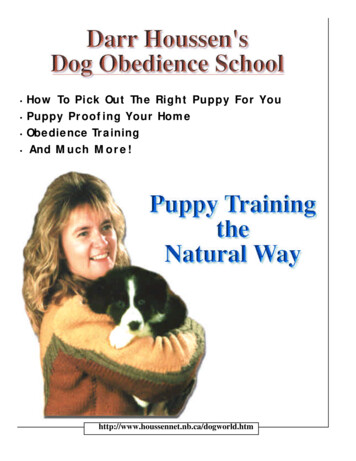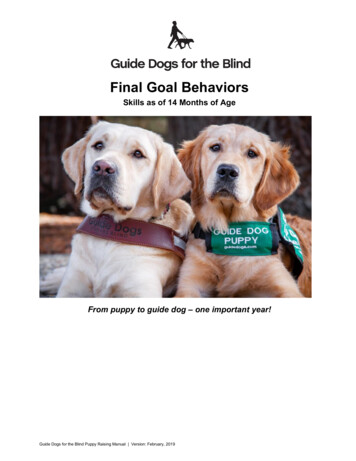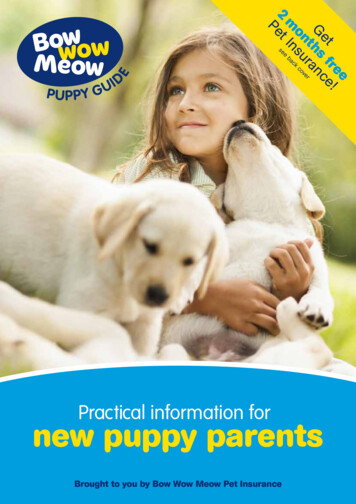
Transcription
EDere !et f eG s nchtra veron su k com In bac2 t seePeIUP UPPY GPractical information fornew puppy parentsBrought to you by Bow Wow Meow Pet Insurance
IDEIDEP UPPY G UP UPPY G Uwelcome & congratulations onyour new puppy!Now that you have welcomed your new family member home,let’s get you and your clumsy, playful bundle of joy off to thebest possible start.This booklet aims to assist you in becoming a good puppy parentand to help you learn what it takes to raise a well balanced,confident puppy. We answer some of the most commonpuppy-raising questions and give advice on important topicssuch as where your puppy should sleep at night, establishing rulesand routines as well as what to feed him or her.This guide has been written by dog trainers and checked by vets.It has a lot of helpful hints, checklists and interactive elements foryou to complete. We hope that you find it valuable.Remember to take it slowFrom the time your puppy enters your life, you will be teachinghim or her new things every day. The first few days together areexciting, as everyone enjoys getting to know each other it isindeed a very special time!Your puppy is young and vulnerable and craves nothing but youraffection and attention. What your puppy needs most is stability,safety and routine. It is very normal to want to show off yournew family member to your extended family and friends. Take iteasy for the first few days and let your puppy settle in with youfirst. Get to know each other - you want your puppy to bondwith you and feel safe and comfortable before inviting peopleover or exposing your puppy to too many new experiences.Enjoy your new family member and these whirlwindpuppy days they grow up way too fast.Boy or girl?One more thing! From now on we will refer to your puppyin the masculine form in order to avoid having to use him/her and he/she throughout the booklet. Of course, all thesame information applies to female puppies too! Pet Tag Holdings Pty Limited 2020Download this guide at bowwowinsurance.com.au/mypuppy2l
IDEP UPPY G UcontentsBringing your puppy homeGiving your new pup the best startPuppy’s first nightChoosing your puppy’s nameUsing crates and playpensPuppy-proofing your homeTop 10 most poisonous plants for dogsPuppy arrival equipment checklist44444556Your puppy’s health8Vaccination scheduleKennel coughWormingTicksFleasNeutering / Spaying899999Your adventurous & accident prone puppy10Common pet emergencies11Pet first aid tips11Puppy spa – from head to paw12Your puppy’s diet & weight13How should I feed my puppy?Healthy weightDangerous foods for your puppyGood for humans, good for dogs13141515Socialisation and its importanceWhat does puppy socialisation mean?How to socialise your puppyYour puppy and dog parksSocialisation program for your puppyPuppy school & early learningFinding a good puppy schoolWhat your puppy school course should coverToilet trainingPuppy play - nipping & bitingHome alone planPlaypen and crate training18181819202020Puppies and sleep21Exercising your puppy21Integrating with the family22Establishing family rulesDeciding who does whatTeaching your puppy commands222323Your children & your new puppy getting it right24Lessons to teach your childrenSafe interactions between kids & other dogsGames for kids & dogs to play togetherDog and family safetyKeeping your puppy safe2525252626Understanding how dogs communicate27Puppy body language2816Puppy development stages3016161617Answers to your top puppy questions32What to do if your puppy runs away34Emergency contact information35l3
IDDon’t forgetpet insurance!EIDEP UPPY G UP UPPY G UProtect your puppyfrom the startVisit bowwowinsurance.com.aufor a quotebringing yourpuppy homeWhat an exciting time - after all the waiting, youfinally get to bring your new fur baby home!Giving your new pup thebest startnew life before you get your friendsand extended family to come over.Once you arrive home, ensure that yougive your pup time to investigate his newhome and settle in. This includes showinghim where he is going to sleep, where hiswater bowl is going to be and what toyshe can play with.Puppy’s first nightYour puppy is likely to be hungry fromall the excitement and new experiences.After he has finished investigating and ishappy running around, you can offer himhis first small meal.It is recommended that you use thesame food that the breeder has beengiving your puppy to keep changes toa minimum for the first two weeks. Thecombination of a new brand of food,feeding routine changes and a newenvironment can often be too much fora young puppy. If you do wish to changefood, try to keep it the same for the first10-14 days before changing.Remember, your puppy will be away fromhis litter for the first time and everythingwill be new and scary for him. Take it easyand make sure you don’t invite too manynew people over to say hello. Give yourpuppy time to settle in and adjust to his4lAfter all the excitement of the first day,your puppy will be exhausted and willneed a good rest. However, rememberthat he will be away from his mum andlittermates for the first time and mightbecome restless at night.To help your puppy settle into his newlife with you, it is recommended that youplace his bed or crate next to you at nightat the start. Over time, you can moveyour puppy to his permanent sleepingspot, away from you if you wish.Choosing your puppy’s nameWe suggest that you choose a few namesbefore your puppy arrives. If you needsome inspiration, you can search fromthe thousands of names on our petnames website (bowwow.com.au).Once you get your puppy, say theshortlisted names out loud to him andmake the decision as to which namebest suits his personality. Keep in mindthat you will need to call your puppy’sname across the park, so make sureyou don’t choose a name that’sembarrassing or difficult to pronounce(read more tips at: ).Your puppy is likely to start responding tohis new name after a few repetitions, sokeep repeating it to him once you havechosen it.Using crates and playpensCrate training is great if you wantyour puppy to go on trips with you,or if you’d like to take him on a plane.Once you get your puppy used tosleeping in a crate he will feel happyand relaxed when inside the crate.
Puppies like to investigate and explore. They learn primarilythrough discovering new things with their mouths. They haveno concept of what is dangerous and are very inquisitive, justlike a crawling baby or toddler.4 Check that there aren’t any dangerous items in thegarage that your puppy could pull onto himself;4 Block off any areas in the house you don’t want yourpuppy to have access to – baby gates are useful for thispurpose;It is important to ensure that you puppy-proof your house,garden, garage and any other areas your puppy will haveaccess to. If there is anything you don’t want him to get holdof, put it away. If alone or unsupervised, put your puppy in aplaypen to avoid danger or destruction!4 Ensure that you have adequate fencing around yourTop tips for puppy-proofing your home44 tore all household cleaning products out of yourSpuppy’s reach. The same applies to any sorts of poison,medication etc.;4Hide electrical cables;IDEPuppy-proofing your homeP UPPY G Uproperty, and make sure that your puppy’s head can’tget stuck in the fence;Cover your pool/pond so your puppy can’t fall into it;4 Use baby gates to block your front door if you live ona busy road – puppies don’t have road sense and willfollow you outside;4 Check your garden for dangerous plants, or plants thatmight cause skin irritations. Be mindful of fertilisers,insecticides and especially rat and snail poison– they are deadly to dogs;4 Hide all small kids’ toys so your puppy doesn’t chewand swallow them;4 Many indoor plants can be poisonous to puppies, so it4 If you have stairs, check there are no gaps for youris wise to keep all indoor plants out of reach when yourpuppy is in his chewing and exploration phase.puppy to fall through and make sure that he learnshow to get down the stairs safely;4 Check that your puppy’s sleeping area is safe– remove access to any chewable )(yellowoleander)IMPORTANT: Train your puppy not to chew any plants ortake food off the ground. If your puppy shows any signs ofbeing unwell and you suspect he might have chewed or eatensomething, take a sample of the plant/food to your vet and gethim checked straight away.mena ntMost orSaneph otStodendodbulbsalRhToCo palmagisFato plamsRemember, your pup will thrive on spendingtime with his new family. Make sure that yourpuppy has a spot to settle – whether it is aplaypen or bed – in the vicinity of where thefamily spends most of its time. Having thepuppy’s playpen or bed in the hallway awayfrom the family can make him feel lonelyand unhappy.sIt is a good idea to keep the puppy playpenin your living room or an area where youspend most of your relaxing time – that wayyour puppy can be near you but you won’trisk tripping over him when you are busycooking dinner!gloveoxLiliumsnroA puppy playpen can be useful for bothtoilet training purposes and for keeping yourpup safe at times when you are not able tosupervise him. The playpen should have abed, water, toys and a wee pad.amenyclsnthroomussMunfelsiaBrsIt also helps immensely with house training,as puppies that are confined won’t soil wherethey sleep. Rather, your puppy will wake youup at night to indicate that he needs thetoilet. This gives you the perfect opportunityto take your pup out to where you want himto go the toilet and give him a treat for doingit in the right spot. Another benefit of cratetraining is that even an overnight stay at thevet won’t be very stressful for your dog, as hewill be used to sleeping contently in a crate.Top 10 mostpoisonousplants for dogs(Including iris,tulips, daffodils,bluebells,snowdrops,autumn crocus,and edible bulbslike onions)l5
IDEIDEP UPPY G UP UPPY G Upuppy arrivalequipment checklistGetting a new puppy is anexciting time! Make sure youare fully equipped and readyfor its arrival.Having the right food, suppliesand equipment will helpmaximise your enjoyment ofyour first few days with yournew family member. We haveput together a checklist ofall the supplies you will needto prepare yourself for yourpuppy’s arrival. We suggest thatyou print it out and use it as ashopping guide.6lBasic Supplies4Food dish4Water dish4Dog bedEnsure you get one that will fit your dog onceit is fully grown and make sure that the bedand its covers are washable!4CollarGet a collar that allows you to adjust the sizeas your puppy grows. The collar shouldn’tbe too heavy for your dog’s neck and shouldsit snuggly so that you can fit two fingersunderneath it.4ID tagChoose a quality tag from Bow Wow Meow,your local vet, or order online atpet-tags.com. Get your dog’s nameand two numbers engraved on your tag(in case you can’t be contacted on one of them).4LeadInvest in a good lead with a size appropriateclip that is not too heavy. It should last 2-4years.4Car harness or car seat buckleIn some states you are required by law to keepyour dog secured in the car. Your safety optionsare a car seatbelt buckle, harness or crate.
P UPPY G U4Food for mealsAsk what food the breeder has been feeding the puppy. Wesuggest you keep using the same brand, but if you do want tochange brands please do so gradually otherwise your puppy mayget an upset stomach if transitioned too fast to a new food.4Training treatsWe recommend using natural dry treats that you can keep inyour pockets. Use these for toilet training and also for reinforcinggood manners and behaviour.IDEFoodToys4Puppy chew toysYou will need at least two chew toys to help your puppy lose itsmilk teeth and relieve itchy gums. Choose toys recommended foryour puppy’s age.4Fluffy toysGet a few fluffy toys for him to play with as puppies will oftendestroy fluffy toys, and rotating toys will help to avoid boredom.4Environmental enrichment toysThese are great for mental stimulation, e.g. Kong or Bob-A-LotGrooming4Dog shampoo4BrushGet a soft one for short haired dogs or a wire one for long haireddogs. Even if you are planning to get your dog groomed regularly,you will still need to brush your dog in between grooming toavoid its fur getting matted.4Nail clipperBuy one if you want to clip your dog’s nails yourself. If not,we suggest you take your puppy to your vet or groomer.Miscellaneous4Toilet training pads or pet loo4Baby gates or puppy play pen4Enzymatic stain cleanersThe best ones to buy are from pet stores because they eliminatethe stain as well as the odours that are undetectable by humans.4Paper towels to soak up urine4ADAPTIL collar or dispenserThis can help your puppy settle into its new home the firstfew nights. Read more at adaptil.com.au.4Worming tabletsPuppies need to be wormed regularly. Please follow yourvet’s recommendation for the best tablets and correct dosage.4Flea and tick treatmentPlease follow your vet’s recommendation for the correcttreatment and dosage.4Pet InsurancePuppies can be very adventurous and accident prone, andoften end up hurting themselves whilst they are still growing.It is important to take out insurance from the very start toensure your puppy is always covered. Check out Bow Wow MeowPet Insurance for a free quote: bowwowinsurance.com.auSPECIAL OFFERGet 2 months FREEpet insurance for your puppy #!Use promo code PGP348when getting a quote atbowwowinsurance.com.aul7
IDEIDEP UPPY G UP UPPY G Uyour puppy’s healthOnce your puppy settles in withyou, we suggest that you makean appointment with your vetof choice for a check-up. Use thisinitial vet appointment to discussany concerns or issues you mighthave, to check your puppy’sweight, overall health and itsvaccination papers.Don’t forget pet insurance!Protect your puppy from the startVisit bowwowinsurance.com.au for a quote8lMost breeders would have had a last vetcheck prior to your puppy’s departureand will give instructions as to when yourpuppy is due for his second vaccinationand next worming. If this is the case,schedule your first vet visit for when thisis due.We recommend that you take out petinsurance prior to your first puppy checkup so that you will be covered for anypotential issues or medical conditionsfrom the start. You can insure your petfrom 8 weeks of age. Find out more at:bowwowinsurance.com.auIf your breeder or the organisation you gotyour puppy from has not given you muchinformation, or you are concerned aboutsomething, we recommend that you set upa vet appointment soon after your puppyarrives home.Vaccination scheduleWhen going for your first vet visit, ensurethat you carry your puppy in and avoidcontact with other dogs until your puppyhas had his second vaccination (unlessadvised otherwise by your vet). Bringplenty of treats with you to make yourpuppy’s first vet visit a positive experience.Puppies need to be vaccinated to protectthem from disease. The earlier he getshis vaccinations, the earlier you can startsocialising your puppy without worryingabout him catching anything nasty.Your puppy will have received his firstvaccination at the breeder between 6-8weeks of age. You are responsible fortaking your puppy for his second and thirdvaccinations. These tend to be four weeksapart from each other – we recommendfollowing your vet’s advice on actual timing.
IDEP UPPY G UKennel coughKennel cough is a virus that can becaught by your puppy even if it has beenvaccinated. It’s like having the flu, and apuppy with kennel cough will be coughingand feeling miserable. It is recommendedyou take your puppy to the vet and keep itunder strict quarantine to avoid spreadingthe kennel cough. Carry your puppy intothe vet and avoid contact with otherdogs until your puppy gets a clean bill ofhealth. Although kennel cough can soundterrible, most of the time it is not a seriouscondition, and most dogs will recoverwithout treatment.How to remove a tickusing tweezersWhere to check for ticksTicks like it where it’s warmand moistCheck your dog’s fur top to bottomCheck in between its pawsCheck gumsCheck inside earsWormingWorming your puppy is important, andpuppies need to be wormed regularlyto avoid illness. Contrary to what youmay think, worms have nothing to dowith hygiene and can be passed to yourpuppy through its mother’s milk. Untiltheir first vaccination, puppies need to bewormed every two weeks. After that, therecommended frequency is four times ayear. If you do find worms in your puppy’spoo, worm your puppy immediately, evenif he might not be due for another coupleof weeks. Worms can make your puppyfeel lethargic, vomit, have diarrhoea andeven lose hair.TicksSpring and summer is peak season forthese nasty little creatures. Ticks aredangerous as they can transmit diseases.A bite from a paralysis tick can causeparalysis and other serious healthproblems for your puppy. To protect yourpuppy there are various tick preventionproducts on the market. Please consultwith your vet as to which is the bestCheck eyelids and near the noseCheck under tailproduct for your area and your puppy.If you live in a tick area, daily tick checksare recommended.FleasIt is very important that you use fleaprevention treatment as directed to avoidthe painful consequences of infestation.Fleas can not only live on your puppy, theireggs can survive for months in carpets,dog beds and any other area where yourdog likes to lie. Therefore, getting rid of thefleas on your dog may only be successful fora short period, as once your puppy goes backto the flea infested areas it can act as a hostand the flea cycle can start all over again. Ifyou find fleas, it is recommended that youwash all bedding and other areas whereyour puppy has been hanging out.It may also be necessary to flea bombyour house.Grasp the tick as close to yourdog’s skin as possible, but begentle! Try not to pinch yourdog’s skin.Pull outward in a straight, steadymotion, making sure you’veremoved the entire tick, sinceanything left behind could leadto an infectionPlease do NOT place petroleum,nail polish or other suchsubstances on the tick, this willjust increase the chance of aninfection.Neutering/SpayingResponsible dog ownership meansspaying or neutering your dog, whichis best done when your puppy is under6 months of age. There are variousreasons for desexing, with the biggestone being to avoid your dog from havingunexpected puppies. There are alreadythousands of unwanted dogs in poundsacross Australia, with many animals putdown every year.Please consult with your vet aboutdesexing your puppy – he/she will guideyou as to the best time and procedurefor your puppy.l9
IDEIDEP UPPY G UP UPPY G Uyour puppy. .very adventurous andhighly accident proneYou’ve just brought your new puppyhome and it is as happy and healthy ascan be. The last thing you want to thinkabout is “What happens when ?”. Butthe truth is that puppies, like children,are very adventurous and accidentprone, and often end up hurtingthemselves whilst they are still growing.A puppy’s immune system also isn’t asdeveloped as it is in adult dogs. This meansthey are more vulnerable to gettinginfections and catching diseases, whichcan sometimes be fatal. Some of the mostcommon infections diagnosed in puppiesare gastrointestinal, skin and eye infections.DID YOU KNOW?The top 3 accidental injuriesin puppies are:1Fractures2Ingestion of foreign objects3 Bite wounds (from otherdogs/snakes)It is important to take out pet insurancefrom the very start, to ensure that yourpuppy is always covered before anypre-existing conditions are diagnosed.Bow Wow Meow is Australia’s No. 1 ratedPet Insurer and winner of Product Review’s2020 Pet Insurer of the Year. We willcover your puppy from 8 weeks of age foraccidents and illnesses.Stanley’s Bone Deformity“When our puppy Stanley was nine months old, he needed to have surgery on his front rightleg. Whilst he’d been growing from a pup, the bones in his right leg had grown at differentrates, with one stopping growing before the other, causing his leg to bow. So at nine monthsold Stan was nearly lame, in incredible pain, and showing signs of arthritis in two of his littlejoints. He required surgery to fix the problem. We had only been customers with Bow WowMeow for a very short period of time when Stanley required this surgery, and we were justamazed that our claim was accepted and processed with a minimum of fuss. From start tofinish, we accumulated over 4,000 in vet bills, and Bow Wow Meow reimbursed us for everybill. We cannot say enough about the service we received, and it was such a comfort to knowthey had our backs during a difficult period.” – Rachel and GaryMaddy’sLeg Surgery“Our ItalianGreyhound Maddybroke her leg whenshe was 8 months old.It was a bad break and required a plateto be inserted to support the shatteredbone. Her surgery cost more than 3,000and would have been unaffordable ifnot for Bow Wow Meow Pet Insurance.This photo was taken at 2016 GeelongShow. Maddy won her class and wasrunner up for best of breed. When shebroke her leg and the vet told me sheneeded an operation to insert a plate,I was convinced her show career was over.Her leg has healed well and she is nowback in the show ring and doing well.You can’t tell that her leg was ever injured.Thanks Bow Wow Meow.” – JenniferSPECIAL OFFERGet 2 months FREEpet insurance for your puppy #!Use promo code PGP348 when getting a quote “Our six monthold Maltese Crosspuppy Jackson wasdiagnosed with a luxating patella, whichmeans that his knee would dislocatecontinuously when he was walking.We took Jackson to an orthopedicsurgeon who performed a kneereconstruction and Jackson is now nearlyfully recovered. We were very fortunateto have pet insurance, as the operationand treatment cost close to 4,000.Bow Wow Meow provided us withprompt, courteous and helpful serviceand we are very thankful to themfor their assistance as it ensured thatJackson could receive the best possibletreatment”. – Carin and Chris
IDEP UPPY G UCOMMON PET icals, foods,allergic reactionsSeizures, severe limp,unconsciousnessBites, bleeding,impactsHeat stroke,heat stressChoking, severevomiting, refusalto eat/drinkEye injury, inabilityto pass waste, bloodin wasteYou should always seek veterinary help if you suspect your pet has any of the above conditions.Make sure you keep your vet and emergency service’s contact information easily accessible.pet firstaid tipsSEIZURESCHOKINGI f choking, hold theupper jaw open withone hand, and look for aforeign object. The most important thingto do is protect your petfrom self-injury. DO NOT place your fingers nless you can clearlyUsee and grasp theobstruction, do not putyour fingers into yourdog’s mouth or throat.or any object in your pet’smouth.NUTS Clear the area around yourNUTSpet to help prevent injuryduring the seizure. o NOT attempt to restrainDyour pet, however you canplace a hand on their body. When the seizure hasstopped, contact yourveterinarian for furtherinstructions.I f the seizure does not stopwithin 3 to 5 minutes, orif your pet comes out ofthe seizure and goes intoanother one within anhour, transport the dogimmediately to the vet.NUTSWOUND CAREPOISON If you suspect poisoning, Place pressure withseek care immediately.gauze or a clean cloth tostop bleeding.I f there is debris, flushthe wound with saline orclean water. For deep wounds orsevere bleeding, keeppressure on the wounduntil you can get yourpet to a vet.NUTSI f you cannot get to thevet immediately, pleasecall the Animal PoisonsHelpline on 1300 869 738.This service is free for petowners and provides firstaid and triage advise foryour pet in the event ofpoisoning. Lift smaller dog’s legs intothe air so gravity can helpdislodge the obstruction. If you can’t remove theforeign object, usingthe heel of your hand,deliver 4-5 sharp blowson the dog between theshoulder blades.l 11
IDEIDEP UPPY G UP UPPY G UPuppy Spa – from head to pawBathingEarsBathing your puppy too often can causeyour puppy’s skin to dry out. It can startlooking dull and your pup might showsigns of dandruff. Try to wash yourpuppy only when it is dirty or has rolledin mud, and use only pet shampoos.Brushing your puppy regularly isrecommended. Brushing helps withblood circulation and can reduceshedding if done weekly.Check your puppy’s ears regularly – werecommend every two weeks, especiallywhen you have a puppy with long floppyears, where dirt can easily collect andcan cause ear infections. If your puppyis shaking his head a lot and trying toscratch his ears with his paws, this couldbe a sign of an ear infection or too muchdirt in your puppy’s ears. Get him checkedout by your vet if you have any concerns.GroomingEyesThis applies to long fur breeds such asschnauzers, poodles or any hybrid breedsthat are mixed with poodles or otherlong haired dogs. These dogs requireregular grooming to prevent their furfrom matting. It is recommended thatyour dog visits the grooming salonevery 8-12 weeks.Regular cleaning is recommended tokeep the eye area clean from dust anddirt, especially if you have a breed thatrequires grooming around its face. Thehair near their eyes can cause dirt tocollect and tear ducts to block.When taking your puppy for its firstgroom, ask for a quiet day at thegrooming salon and mention that it isyour puppy’s first groom. The groomercan only do a good job if your puppy isn’tscared. Get your puppy used to noise theywill be exposed to at the salon by usingthe Sound Proof Puppy Training App fromthe iOS and Android App store.Puppy teeth will start falling out fromfour months of age. Start checking yourpuppy’s teeth around this time to ensurethat all milk teeth fall out and the newcanines start coming through.12 lTeethNailsOnce your puppy starts walking onpavements, his nails will be trimmednaturally by walking on the hard surface.If they need further trimming, wesuggest you take your puppy to yourvet or groomer.Anal glandsNot a sexy topic, but we thought we’dcover it! Dogs have two small analglands next to their anus, which shouldget expressed when your dog poops. Ifyour puppy has lots of soft stools theymight not get expressed and it can getuncomfortable. Your pup might startrubbing his bum on the floor to emptythem, or let off some really smelly farts.A groomer or vet will be able to helpwith emptying them, or, if youare super keen,you can learn onYouTube how todo it yourself!
IDEP UPPY G Uyour puppy’sdiet & weightHow should I feed my puppy?The world of pet food can be head spinning. From differentbrands of dry food to raw diets, there is a huge range ofoptions to choose from.It is best to keep your puppy on the same food that thebreeder started your puppy off with. Once your puppyhas settled in and you want to move him to a differentfood type, you can slowly start to transition him over.Dogs have a sensitive digestive system, much more sensitivethan ours. It is therefore recommended to transition yourpuppy to a new brand of food over the course of 7-10 daysto avoid runny stools and upset stomachs.To start, a recommended approach is to use 80% old foodon day one and 20% new food. The following day you giveyour puppy 70% old food and 30% new food and so on,decreasing the old food and increasing the new food by10% each day. Over the course of 7-10 days you will havetransitioned your puppy to his new food and hopefullywill have avoided loose stools and an upset tummy.It is important to stick with one food. If you feed him dryfood, stay with one brand and do not mix as this couldupset your dog’s digestive system.OLD FOODNEW FOODDay 18020Day 27030Day 36040Day 45050Day 54060Day 63070Day 72080Day 81090Day 90100 TIPIf during the transitionperiod your puppygets loose stools, stayon the same rationfor another day. Itmight take you longerto transition, butyou will be avoidinga mess and helpingyour puppy’s digestivesystem to catch up.l 13
IDEIDEP UPPY G UP UPPY G UThe following ingredients in dog food should be avoided:Bone mealWheat flourPotato productBHTMeat by-productsSoy flourSugarPropyl GallateTallowBrewer’s riceColouringEthoxyquinAnimal fatCelluloseBHAHydrochloric AcidCornHow much should I feed?Healthy weightAn overweight puppy will be more likely to grow into anoverweight adult dog. As your puppy is growing, carryingexcess weight is not good for his joints.We recommend using a calculating chart, e.g. puppychart.com,to help you stay on top of your puppy’s weight gain and ensurethat your puppy stays in the recommended weight range as hematures. Remember to always consult your vet if you have anyconcerns about your puppy’s weight gain.Once your dog is fully grown, below is a good picture chartto help you assess his ideal weight:How much to feed depends on the brand of food youare feeding and your puppy’s weight. You will need toadjust the quantity of food you are feeding over timeas your puppy grows. It is therefore recommendedthat you weigh your puppy weekly to ensure he isputting on a healthy amount of weight. Always readand follow the instructions on the food packaging.How often should I feed?Puppies under 6 months of age should be fed smallquantities three times a day. After 6 months you canmove to two feeds a day. If you work, three feeds a dayisn’t always feasible. Don’t stress if you can only feed yourpuppy two meals a day.What should I feed my puppy?Your puppy is growing and requires the best nutrients,so look for a good quality food. Quality food is not onlyabout the price tag, it is more about the ingredients.If a brand of pet food contains lots of preservatives,fillers, sugar and salt, then it is not a good quality food.Quality foods are sold predominantly in pet stores andby vets rather than in supermarkets.Raw feedingRaw feeding can have a lot of benefits, includingshinier coats, healthier skin, cleaner teeth, higher energylevels and smaller st
Download this guide at bowwowinsurance.com.au/mypuppy 2 l PU Y G D E. contents Bringing your puppy home 4 Giving your new pup the best start 4 . Crate training is great if you want your puppy to go on trips with you, or if you'd like to take him on a plane. Once you get your puppy used to
